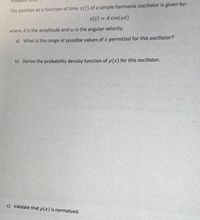Question

Transcribed Image Text:The position as a function of time x(t) of a simple harmonic oscillator is given by:
x(t) = A cos(wt)
%3D
where A is the amplitude and w is the angular velocity.
a) What is the range of possible values of x permitted for this oscillator?
b) Derive the probability density function of p(x) for this oscillator.
c) Validate that p(x) is normalized.
Expert Solution
This question has been solved!
Explore an expertly crafted, step-by-step solution for a thorough understanding of key concepts.
This is a popular solution
Trending nowThis is a popular solution!
Step by stepSolved in 3 steps with 3 images

Knowledge Booster
Similar questions
- We have a free particle in one dimension at a time t = 0, the initial wave function is (x, 0) = Ae-r|æ| where A and r are positive real constants. Calculate the expectation value (p).arrow_forwardA particle is described by the wavefunction below, where L = 1 nanometer. a) Determine the value of the constant c. b) Draw the graphs of the wavefunction and the probability density. c) Calculate the probability of finding the particle in the region x > 1 nanometerarrow_forwardA particle confined in a one-dimensional box of length L(<= X <= L) is in a state described by the wave function where **check attached image** where A and B are constants given by real numbers. A) Determine which relationship A and B must satisfy for the wavefunction to be normalized. B) Suppose that A = B. What is the probability of the particle being found in the interval 0 <= X <= L/2? C) What are the values of A and B that minimize the probability of finding the particle in the range of positions 0 <= X <= L/2?arrow_forward
- QUESTION 1 The expectation value is the strict average of the possible values. O True Falsearrow_forwardOne-dimensional harmonic oscillators in equilibrium with a heat bath (a) Calculate the specific heat of the one-dimensional harmonic oscillator as a function of temperature. (b) Plot the T -dependence of the mean energy per particle E/N and the specific heat c. Show that E/N → kT at high temperatures for which kT > hw. This result corresponds to the classical limit and is shown to be an example of the equipartition theorem. In this limit the energy kT is large in comparison to ħw, the separation between energy levels. Hint: expand the exponential function 1 ē = ħw + eBhw (c) Show that at low temperatures for which ħw> kT , E/N = hw(+e-Bhw) What is the value of the heat capacity? Why is the latter so much smaller than it is in the high temperature limit? Why is this behavior different from that of a two-state system? (d) Verify that S →0 as T> O in agreement with the third law of thermodynamics, and that at high T,S> kN In(kT / hw).arrow_forwardThe wave function W(x,t)=Ax^4 where A is a constant. If the particle in the box W is normalized. W(x)=Ax^4 (A x squared), for 0<=x<=1, and W(x) = 0 anywhere. A is a constant. Calculate the probability of getting a particle for the range x1 = 0 to x2 = 1/3 a. 1 × 10^-5 b. 2 × 10^-5 c. 3 × 10^-5 d. 4 × 10^-5arrow_forward
- A particle is described by the wavefunction Ψ(t, x), and the momentum operator is denoted by pˆ. a) Write down an expression for the differential operator pˆ. b) Write down an expression for the expectation value of the momentum, ⟨p⟩. c) Write down an expression for the probability density, ρ. d) Write down an expression for the probability of finding the particle between x = a and x = b.arrow_forwardQuestion A2 Consider an infinite square well of width L, with V = 0 in the region -L/2 < x < L/2 and V → ∞ everywhere else. For this system: a) Write down and solve the time-independent Schrödinger equation for & inside the well, where -L/2< xarrow_forwardConsider the superposition wave function (x) = c sin (πx/a) + d sin (2πx/a). a. Is (x) an acceptable wave function for the particle in the box? b. Is(x) an eigenfunction of the total energy operator Ĥ? c. Is(x) normalized?arrow_forward
arrow_back_ios
arrow_forward_ios